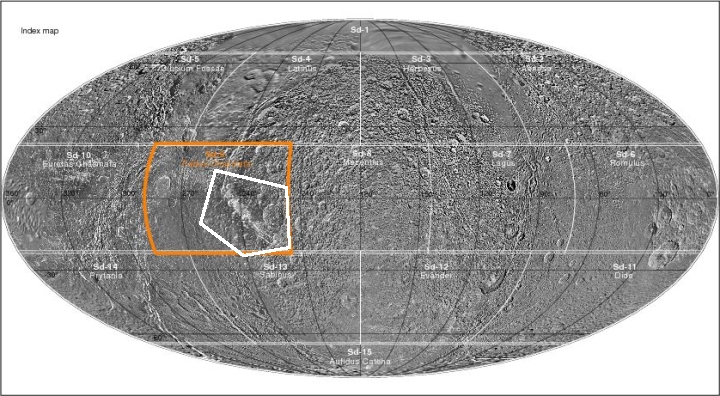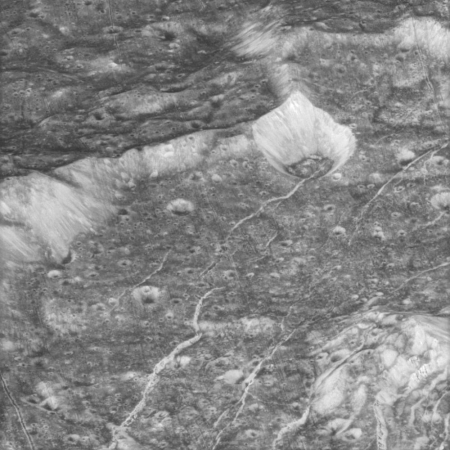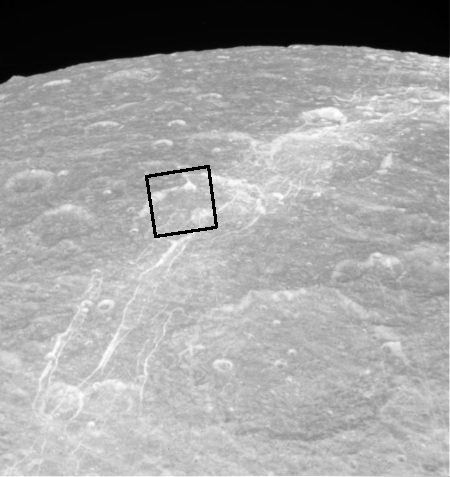A journey to Saturn’s moon Dione

Cool image time! Today, for a change, I decided to spend some time rummaging through the Cassini raw image archive, mainly because I wanted to see some variety. At this time sadly almost all the good images coming from space are limited to Mars images, and I wished to post a cool image from somewhere else in the solar system.
The global map above was compiled from photographs of the Saturn moon Dione taken by Cassini during its thirteen years in orbit around the ringed giant.
The orange box indicates the sector of interest. The white outline indicates the location of the next photograph below and to the right, taken by Cassini during its first close fly-by of the moon on October 11, 2005, when the spacecraft was approaching the moon.
The black box in the approach image to the right indicates the location of the close-up below. It covers a region dubbed Padua Chasmata, named for the white lined features running north-south near its center and separating the heavily cratered terrain to the east and the smoother plains to the west.
To help you understand the Cassini image, note that the spacecraft was approaching from the east, so that the approach image looks west. You can see Padua Chasmata cutting diagonally across the photograph. The giant shallow crater to the east of the chasmata is clearly visible on the global map above.
The black box indicates the location of one of 20 close-up images taken during that fly-by, and which I have posted below and to the right.

Click for full resolution image.
The photograph was taken from about 2,787 miles, with a resolution of 75 feet per pixel.
The Cassini science team gave this image a press release, noting;
The terrain in this image is located within a 60-kilometer-wide (37-mile) impact crater along the feature called Padua Linea. The western rim of the encompassing crater runs from the middle left to the upper right. The crater’s central peak can be seen at the lower right.
Multiple generations of fractures are visible here. Numerous fine, roughly parallel linear grooves run across the terrain from top to bottom and are interrupted by the larger, irregular bright fractures. In several places, fractures postdate some deposits in the bottoms of craters that are not badly degraded by time. Such a fracture, for example, runs from the center toward the upper right.
Most of the craters seen here have bright walls and dark deposits of material on their floors. As on other Saturnian moons, rockslides on Dione may reveal cleaner ice, while the darker materials accumulate in areas of lower topography and lower slope (e.g. crater floors and the bases of scarps).
This close-up photograph showed that the white lines of Padua Chasmata were both cliffs and fractures. Also, note now the largest white cliff near the top slight to the right of center appears to be the wall of a small crater, as if that impact had sliced down the side of the larger crater rim wall as it came in.
The make-up of these cliffs and fractures is only vaguely known. We know even less of the geological processes going on here, though scientists of course have made some educated guesses.
While Cassini did a number of additional close flybys of Dione in the next dozen years, none was ever as close. Cassini is now gone, so we shall not get a better view of this terrain until a new mission arrives, something that is likely not to occur for many decades. At the moment the only mission planned for Saturn, Dragonfly, is going to head to the moon Titan. At the moment it does not look like the mission will include a Saturn orbiter.
On Christmas Eve 1968 three Americans became the first humans to visit another world. What they did to celebrate was unexpected and profound, and will be remembered throughout all human history. Genesis: the Story of Apollo 8, Robert Zimmerman's classic history of humanity's first journey to another world, tells that story, and it is now available as both an ebook and an audiobook, both with a foreword by Valerie Anders and a new introduction by Robert Zimmerman.
The print edition can be purchased at Amazon or from any other book seller. If you want an autographed copy the price is $60 for the hardback and $45 for the paperback, plus $8 shipping for each. Go here for purchasing details. The ebook is available everywhere for $5.99 (before discount) at amazon, or direct from my ebook publisher, ebookit. If you buy it from ebookit you don't support the big tech companies and the author gets a bigger cut much sooner.
The audiobook is also available at all these vendors, and is also free with a 30-day trial membership to Audible.
"Not simply about one mission, [Genesis] is also the history of America's quest for the moon... Zimmerman has done a masterful job of tying disparate events together into a solid account of one of America's greatest human triumphs."--San Antonio Express-News

Cool image time! Today, for a change, I decided to spend some time rummaging through the Cassini raw image archive, mainly because I wanted to see some variety. At this time sadly almost all the good images coming from space are limited to Mars images, and I wished to post a cool image from somewhere else in the solar system.
The global map above was compiled from photographs of the Saturn moon Dione taken by Cassini during its thirteen years in orbit around the ringed giant.
The orange box indicates the sector of interest. The white outline indicates the location of the next photograph below and to the right, taken by Cassini during its first close fly-by of the moon on October 11, 2005, when the spacecraft was approaching the moon.
The black box in the approach image to the right indicates the location of the close-up below. It covers a region dubbed Padua Chasmata, named for the white lined features running north-south near its center and separating the heavily cratered terrain to the east and the smoother plains to the west.
To help you understand the Cassini image, note that the spacecraft was approaching from the east, so that the approach image looks west. You can see Padua Chasmata cutting diagonally across the photograph. The giant shallow crater to the east of the chasmata is clearly visible on the global map above.
The black box indicates the location of one of 20 close-up images taken during that fly-by, and which I have posted below and to the right.

Click for full resolution image.
The photograph was taken from about 2,787 miles, with a resolution of 75 feet per pixel.
The Cassini science team gave this image a press release, noting;
The terrain in this image is located within a 60-kilometer-wide (37-mile) impact crater along the feature called Padua Linea. The western rim of the encompassing crater runs from the middle left to the upper right. The crater’s central peak can be seen at the lower right.
Multiple generations of fractures are visible here. Numerous fine, roughly parallel linear grooves run across the terrain from top to bottom and are interrupted by the larger, irregular bright fractures. In several places, fractures postdate some deposits in the bottoms of craters that are not badly degraded by time. Such a fracture, for example, runs from the center toward the upper right.
Most of the craters seen here have bright walls and dark deposits of material on their floors. As on other Saturnian moons, rockslides on Dione may reveal cleaner ice, while the darker materials accumulate in areas of lower topography and lower slope (e.g. crater floors and the bases of scarps).
This close-up photograph showed that the white lines of Padua Chasmata were both cliffs and fractures. Also, note now the largest white cliff near the top slight to the right of center appears to be the wall of a small crater, as if that impact had sliced down the side of the larger crater rim wall as it came in.
The make-up of these cliffs and fractures is only vaguely known. We know even less of the geological processes going on here, though scientists of course have made some educated guesses.
While Cassini did a number of additional close flybys of Dione in the next dozen years, none was ever as close. Cassini is now gone, so we shall not get a better view of this terrain until a new mission arrives, something that is likely not to occur for many decades. At the moment the only mission planned for Saturn, Dragonfly, is going to head to the moon Titan. At the moment it does not look like the mission will include a Saturn orbiter.
On Christmas Eve 1968 three Americans became the first humans to visit another world. What they did to celebrate was unexpected and profound, and will be remembered throughout all human history. Genesis: the Story of Apollo 8, Robert Zimmerman's classic history of humanity's first journey to another world, tells that story, and it is now available as both an ebook and an audiobook, both with a foreword by Valerie Anders and a new introduction by Robert Zimmerman.
The print edition can be purchased at Amazon or from any other book seller. If you want an autographed copy the price is $60 for the hardback and $45 for the paperback, plus $8 shipping for each. Go here for purchasing details. The ebook is available everywhere for $5.99 (before discount) at amazon, or direct from my ebook publisher, ebookit. If you buy it from ebookit you don't support the big tech companies and the author gets a bigger cut much sooner.
The audiobook is also available at all these vendors, and is also free with a 30-day trial membership to Audible.
"Not simply about one mission, [Genesis] is also the history of America's quest for the moon... Zimmerman has done a masterful job of tying disparate events together into a solid account of one of America's greatest human triumphs."--San Antonio Express-News


